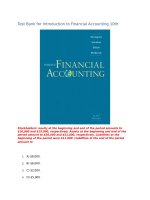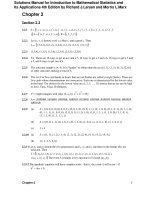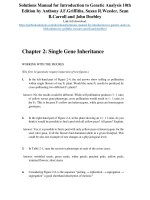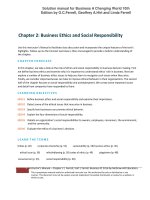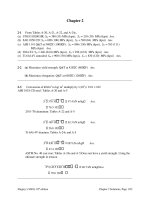Solutions manual for introduction to genetic analysis 10th edition by griffiths wessler carroll and doebley
Bạn đang xem bản rút gọn của tài liệu. Xem và tải ngay bản đầy đủ của tài liệu tại đây (1.09 MB, 48 trang )
Solutions Manual for Introduction to Genetic Analysis 10th
Edition by Anthony J.F.Griffiths, Susan R.Wessler, Sean
B.Carroll and John Doebley
Link full download:
/>
Chapter 2: Single Gene Inheritance
WORKING WITH THE FIGURES
(The first 14 questions require inspection of text figures.)
1.
In the left-hand part of Figure 2-4, the red arrows show selfing as pollination
within single flowers of one F1 plant. Would the same F2 results be produced by
cross-pollinating two different F1 plants?
Answer: No, the results would be different. While self pollination produces 3 : 1 ratio
of yellow versus gene phenotype, cross pollination would result in 1 : 1 ratio, in
the F2. This is because F1 yellow are heterozygous, while green are homozygous
genotypes.
2.
In the right-hand part of Figure 2-4, in the plant showing an 11 : 11 ratio, do you
think it would be possible to find a pod with all yellow peas? All green? Explain.
Answer: Yes, it is possible to find a pod with only yellow peas or heterozygous for the
seed color gene, if all the flowers had dominant allele in a given fruit/pod. This
could be also one example of rare changes at a physiological level.
3.
In Table 2-1, state the recessive phenotype in each of the seven cases.
Answer: wrinkled seeds; green seeds; white petals; pinched pods; yellow pods;
terminal flowers; short stems
4.
Considering Figure 2-8, is the sequence “pairing → replication → segregation →
segregation” a good shorthand description of meiosis?
Chapter Two 7
Answer: No, it should say either: “pairing, recombination, segregation,
segregation” or: “replication, pairing, segregation, segregation.”
5.
Point to all cases of bivalents, dyads, and tetrads in Figure 2-11.
Answer: Replicate sister chromosomes or dyads are at any chromatid after the
replication (S phase). A pair of synapsed dyads is called a bivalent and it would
represent two dyads together (sister chromatids on the right), while the four
chromatids that make up a bivalent are called a tetrad and they would be the entire
square (with same or different alleles on the bivalents).
6.
In Figure 2-12, assume (as in corn plants) that A encodes an allele that produces
starch in pollen and allele a does not. Iodine solution stains starch black. How
would you demonstrate Mendel’s first law directly with such a system?
Answer: One would use this iodine dye to color the starch producing corn pollen. Since
pollen is a plant gametophyte generation (haploid) it will be produced by meiosis.
Mendel’s first law predicts segregation of alleles into gametes, therefore we
would expect 1 : 1 ratio of starch producing (A) versus non-starch producing (a)
pollen grains, from a heterozygous (A/a) parent/male flower. It would be easy to
color the pollen and count the observed ratio.
7.
In the text figure on page 43, assume the left-hand individual is selfed. What
pattern of radioactive bands would you see in a Southern analysis of the progeny?
Answer: If an individual is selfed, the restriction fragments should be identical to the
parents fragments. In this case, a heterozygous parent to the left had three bands
(two from a mutant allele “a” and one from dominant allele “A”).
8.
Considering Figure 2-15, if you had a homozygous double mutant m3/m3 m5/m5,
would you expect it to be mutant in phenotype? (Note: This line would have two
mutant sites in the same coding sequence.)
Answer: Yes, this double mutant m3/m3 and m5/m5 would be a null mutation, because
m3 mutation changes the exon sequence.
9.
In which of the stages of the Drosophila life cycle (represented in the box on page
52) does meiosis take place?
8 Chapter Two
Answer: Meiosis happens in adult ovaries and testes, therefore before fertilization.
After fertilization, fruit flies would lay their eggs (with now diploid embryos).
That would be Stage 1 on the figure.
10.
If you assume Figure 2-17 also applies to mice and you irradiate male sperm with
X rays (known to inactivate genes), what phenotype would you look for in
progeny in order to find cases of individuals with an inactivated SRY gene?
Answer: If we inactivate the SRY gene in mammals with radiation, the offspring should
all be phenotypically females, yet on the chromosome level there would be both
XX and XY (in this case sterile, female looking males).
11.
In Figure 2-19, how does the 3 : 1 ratio in the bottom-left-hand grid differ from
the 3 : 1 ratios obtained by Mendel?
Answer: It differs because in Mendel’s experiments, we learned about autosomal
genes, while in this case we have a sex linked gene for eye color.
3 : 1 ratio means that all females have red eyes (X+/–), while half the males have red
(X+/Y) and half white (XW/Y).
Careful sex determination when counting F2 offspring would point out to a sex linked
trait.
12.
In Figure 2-21, assume that the pedigree is for mice, in which any chosen cross
can be made. If you bred IV-1 with IV-3, what is the probability that the first baby
will show the recessive phenotype?
Answer: The answer would be:
2/3
2/3
1/4 = 1/9 or 0.11
Probability that IV 1 and IV 3 mice are heterozygous is 2/3. This is because both of
their parents are known heterozygotes (A/a) and since they are dominant
phenotype they could only be A/A or A/a. Now, probability that two
heterozygotes have a recessive homozygote offspring is 1/4.
13.
Which part of the pedigree in Figure 2-23 in your opinion best demonstrates
Mendel’s first law?
Chapter Two 9
Answer: Any part of this pedigree demonstrates the law, showing segregation of alleles
into gametes. The middle part of generation II marriage shows a typical test cross
(expected 1:1). Neither ratio in the pedigree could be confirmed because of a
small sample size in any given family, but allele segregation is obvious.
14.
Could the pedigree in Figure 2-31 be explained as an autosomal dominant
disorder? Explain.
Answer: Yes, it could in some cases, but in this case we have clues that the pedigree
is for a sex linked dominant trait. First, if fathers have a gene, daughters will
receive it only, and second, if mother has a gene, both sons and daughters would
receive it.
BASIC PROBLEMS
15. Make up a sentence including the words chromosome, genes, and genome.
Answer: The human genome contains an estimated 20,000–25,000 genes located on
23 different chromosomes.
16. Peas (Pisum sativum) are diploid and 2n = 14. In Neurospora, the haploid fungus,
n = 7. If it were possible to fractionate genomic DNA from both species by using
pulsed field electrophoresis, how many distinct DNA bands would be visible in
each species?
Answer: PFGE separates DNA molecules by size. When DNA is carefully isolated
from Neurospora (which has seven different chromosomes) seven bands should
be produced using this technique. Similarly, the pea has seven different
chromosomes and will produce seven bands (homologous chromosomes will comigrate as a single band).
17. The broad bean (Vicia faba) is diploid and 2n = 18. Each haploid chromosome
set contains approximately 4 m of DNA. The average size of each chromosome
during metaphase of mitosis is 13 m. What is the average packing ratio of DNA
at metaphase? (Packing ratio = length of chromosome/length of DNA molecule
therein.) How is this packing achieved?
Answer: There is a total of 4 m of DNA and nine chromosomes per haploid set. On
average, each is 4/9 m long. At metaphase, their average length is 13 µm, so the
10 Chapter Two
average packing ratio is 13 10–6 m : 4.4 10–1 m or roughly 1 : 34,000! This
remarkable achievement is accomplished through the interaction of the DNA with
proteins. At its most basic, eukaryotic DNA is associated with histones in units
called nucleosomes and during mitosis, coils into a solenoid. As loops, it
associates with and winds into a central core of nonhistone protein called the
scaffold.
18. If we call the amount of DNA per genome “x,” name a situation or situations in
diploid organisms in which the amount of DNA per cell is:
a. x
b. 2x
c. 4x
Answer: Because the DNA levels vary four-fold, the range covers cells that are haploid
(gametes) to cells that are dividing (after DNA has replicated but prior to cell
division). The following cells would fit the DNA measurements:
x+ haploid cells
2x diploid cells in G1 or cells after meiosis I but prior to meiosis II
4x diploid cells after S but prior to cell division
19. Name the key function of mitosis.
Answer: The key function of mitosis is to generate two daughter cells genetically
identical to the original parent cell.
20. Name two key functions of meiosis.
Answer: Two key functions of meiosis are to halve the DNA content and to reshuffle
the genetic content of the organism to generate genetic diversity among the
progeny.
21. Can you design a different nuclear-division system that would achieve the same
outcome as that of meiosis?
Answer: It’s pretty hard to beat several billions of years of evolution, but it might be
simpler if DNA did not replicate prior to meiosis. The same events responsible
for halving the DNA and producing genetic diversity could be achieved in a single
cell division if homologous chromosomes paired, recombined, randomly aligned
Chapter Two 11
during metaphase, and separated during anaphase, etc. However, you would lose
the chance to check and repair DNA that replication allows.
22. In a possible future scenario, male fertility drops to zero, but, luckily, scientists
develop a way for women to produce babies by virgin birth. Meiocytes are
converted directly (without undergoing meiosis) into zygotes, which implant in
the usual way. What would be the short- and long-term effects in such a society?
Answer: In large part, this question is asking, why sex? Parthenogenesis (the ability to
reproduce without fertilization—in essence, cloning) is not common among
multicellular organisms. Parthenogenesis occurs in some species of lizards and
fishes, and several kinds of insects, but it is the only means of reproduction in
only a few of these species. In plants, about 400 species can reproduce asexually
by a process called apomixis. These plants produce seeds without fertilization.
However, the majority of plants and animals reproduce sexually. Sexual
reproduction produces a wide variety of different offspring by forming new
combinations of traits inherited from both the father and the mother. Despite the
numerical advantages of asexual reproduction, most multicellular species that
have adopted it as their only method of reproducing have become extinct.
However, there is no agreed upon explanation of why the loss of sexual
reproduction usually leads to early extinction or conversely, why sexual
reproduction is associated with evolutionary success.
On the other hand, the immediate effects of such a scenario are obvious. All offspring
will be genetically identical to their mothers, and males would be extinct within
one generation.
23. In what ways does the second division of meiosis differ from mitosis?
Answer: As cells divide mitotically, each chromosome consists of identical sister
chromatids that are separated to form genetically identical daughter cells.
Although the second division of meiosis appears to be a similar process, the
“sister” chromatids are likely to be different. Recombination during earlier
meiotic stages has swapped regions of DNA between sister and nonsister
chromosomes such that the two daughter cells of this division typically are not
genetically identical.
24. Make up mnemonics for remembering the five stages of prophase I of meiosis
and the four stages of mitosis.
12 Chapter Two
Answer: The four stages of mitosis are: prophase, metaphase, anaphase, and telophase.
The first letters, PMAT, can be remembered by a mnemonic such as: Playful Mice
Analyze Twice.
The five stages of prophase I are: leptotene, zygotene, pachytene, diplotene, and
diakinesis. The first letters, LZPDD, can be remembered by a mnemonic such as:
Large Zoos Provide Dangerous Distractions.
25. In an attempt to simplify meiosis for the benefit of students, mad scientists
develop a way of preventing premeiotic S phase and making do with having just
one division, including pairing, crossing over, and segregation. Would this system
work, and would the products of such a system differ from those of the present
system?
Answer: Yes, it could work but certain DNA repair mechanisms (such as
postreplication recombination repair) could not be invoked prior to cell division.
There would be just two cells as products of this meiosis, rather than four.
26. Theodor Boveri said, “The nucleus doesn’t divide; it is divided.” What was he
getting at?
Answer: The nucleus contains the genome and separates it from the cytoplasm.
However, during cell division, the nuclear envelope dissociates (breaks down). It
is the job of the microtubule-based spindle to actually separate the chromosomes
(divide the genetic material) around which nuclei reform during telophase. In this
sense, it can be viewed as a passive structure that is divided by the cell’s
cytoskeleton.
27. Francis Galton, a geneticist of the pre-Mendelian era, devised the principle that
half of our genetic makeup is derived from each parent, one-quarter from each
grandparent, one-eighth from each great-grandparent, and so forth. Was he right?
Explain.
Answer: Yes, half of our genetic makeup is derived from each parent, each parent’s
genetic makeup is derived half from each of their parents, etc.
28. If children obtain half their genes from one parent and half from the other parent,
why aren’t siblings identical?
Chapter Two 13
Answer: Because the “half” inherited is very random, the chances of receiving exactly
the same half is vanishingly small. Ignoring recombination and focusing just on
which chromosomes are inherited from one parent (for example, the one they
inherited from their father or the one from their mother?), there are 223 =
8,388,608 possible combinations!
29. State where cells divide mitotically and where they divide meiotically in a fern, a
moss, a flowering plant, a pine tree, a mushroom, a frog, a butterfly, and a snail.
Answer:
Mitosis
Meiosis
fern
sporophyte
gametophyte
(sporangium)
moss
sporophyte
gametophyte
plant
sporophyte
gametophyte
sporophyte
gametophyte
sporophyte
(antheridium and
archegonium)
sporophyte (anther
and ovule)
sporophyte (pine
cone)
mushroom
sporophyte
gametophyte
sporophyte (ascus or
basidium)
frog
somatic cells
gonads
butterfly
somatic cells
gonads
snail
somatic cells
gonads
pine tree
30. Human cells normally have 46 chromosomes. For each of the following stages,
state the number of nuclear DNA molecules present in a human cell:
a. metaphase of mitosis.
b. metaphase I of meiosis.
c. telophase of mitosis.
d. telophase I of meiosis.
e. telophase II of meiosis.
Answer: This problem is tricky because the answers depend on how a cell is defined.
In general, geneticists consider the transition from one cell to two cells to occur
with the onset of anaphase in both mitosis and meiosis, even though cytoplasmic
division occurs at a later stage.
14 Chapter Two
a.
b.
c.
d.
46 chromosomes, each with two chromatids = 92 chromatids
46 chromosomes, each with two chromatids = 92 chromatids
46 physically separate chromosomes in each of two about-to-be-formed cells
23 chromosomes in each of two about-to-be-formed cells, each with two
chromatids = 46 chromatids
e. 23 chromosomes in each of two about-to-be-formed cells
31. Four of the following events are part of both meiosis and mitosis, but only one is
meiotic. Which one? (1) chromatid formation, (2) spindle formation, (3)
chromosome condensation, (4) chromosome movement to poles, (5) synapsis.
Answer: (5) chromosome pairing (synapsis)
32. In corn, the allele ƒ´ causes floury endosperm and the allele f´´ causes flinty
endosperm. In the cross ƒ´/ƒ´ [female symbol] ƒ´´/ƒ´´ [male symbol], all the
progeny endosperms are floury, but in the reciprocal cross, all the progeny
endosperms are flinty. What is a possible explanation? (Check the legend for
Figure 2-7.)
Answer: First, examine the crosses and the resulting genotypes of the endosperm:
Female
Male
ƒ´/ƒ´
ƒ´´/ƒ´´
Polar
nuclei
ƒ´ and ƒ´
Sperm
Endosperm
ƒ´´/ƒ´´
ƒ´/ƒ´/ƒ´´
(floury)
ƒ´´/ƒ´´/ƒ´
(flinty)
ƒ´´/ƒ´´
ƒ´/ƒ´
ƒ´´ and ƒ´´ ƒ´/ƒ´
As can be seen, the phenotype of the endosperm correlates to the predominant allele
present.
33. What is Mendel’s first law?
Answer: Mendel’s first law states that alleles segregate into gametes during meiosis.
This discovery came from his monohybrid experimental crosses.
34. If you had a fruit fly (Drosophila melanogaster) that was of phenotype A, what
test would you make to determine if the fly’s genotype was A/A or A/a?
Chapter Two 15
Answer: Do a test-cross (cross to a/a). If the fly was A/A, all the progeny will be
phenotypically A; if the fly was A/a, half the progeny will be A, and half will be a.
35. In examining a large sample of yeast colonies on a petri dish, a geneticist finds an
abnormal-looking colony that is very small. This small colony was crossed with
wild type, and products of meiosis (ascospores) were spread on a plate to produce
colonies. In total, there were 188 wild-type (normal-size) colonies and 180 small
ones.
a. What can be deduced from these results regarding the inheritance of the smallcolony phenotype? (Invent genetic symbols.)
b. What would an ascus from this cross look like?
Answer:
a. A diploid meiocyte that is heterozygous for one gene (for example, s+/s where s is
the allele that confers the small colony phenotype) will, after replication and
segregation, give two meiotic products of genotype s+ and two of s. If the random
spores of many meiocytes are analyzed, you would expect to find about 50 percent
normally sized colonies and 50 percent small colonies if the abnormal phenotype is
the result of a mutation in a single gene. Thus, the actual results of 188 normally
sized and 180 small-sized colonies support the hypothesis that the phenotype is the
result of a mutation in a single gene.
b. The following represents an ascus with four spores. The important detail is that two
of the spores are s and two are s+.
s
s+
s
s+
36. Two black guinea pigs were mated and over several years produced 29 black and
9 white offspring. Explain these results, giving the genotypes of parents and
progeny.
Answer: The progeny ratio is approximately 3:1, indicating classic heterozygous-byheterozygous mating. Since black (B) is dominant to white (b): Parents: B/b
B/b
Progeny: 3 black:1 white (1 B/B : 2 B/b : 1 b/b)
This ratio indicates that black parents were probably heterozygous and that black is
dominant over white.
16 Chapter Two
37. In a fungus with four ascospores, a mutant allele lys-5 causes the ascospores
bearing that allele to be white, whereas the wild-type allele lys-5+ results in black
ascospores. (Ascospores are the spores that constitute the four products of
meiosis.) Draw an ascus from each of the following crosses:
a. lys-5 lys-5+
b. lys-5 lys-5
c. lys-5+ lys-5+
Answer:
a. You expect two lys-5+ (black) spores and two lys-5 (white) spores.
b. You expect all lys-5 (white) spores.
c. You expect all lys-5+ (black) spores.
38. For a certain gene in a diploid organism, eight units of protein product are needed
for normal function. Each wild-type allele produces five units.
a. If a mutation creates a null allele, do you think this allele will be recessive or
mutant?
b. What assumptions need to be made to answer part a?
Answer:
a. You do not expect the mutation to be recessive. This would be an example of a
haploinsufficient gene since one copy of the wild-type allele does produce enough
protein product for normal function.
Chapter Two 17
b. An important assumption would be that having five of eight units of protein product
would result in an observable phenotype. It also assumes that the regulation of the
single wild-type allele is not affected. Finally, if the mutant allele was leaky rather
than null, there might be sufficient protein function when heterozygous with a wildtype allele.
39. A Neurospora colony at the edge of a plate seemed to be sparse (low density) in
comparison with the other colonies on the plate. This colony was thought to be a
possible mutant, and so it was removed and crossed with a wild type of the
opposite mating type. From this cross, 100 ascospore progeny were obtained.
None of the colonies from these ascospores was sparse, all appearing to be
normal. What is the simplest explanation of this result? How would you test your
explanation? (Note: Neurospora is haploid.)
Answer: The simplest explanation is that the abnormal phenotype was not due to an
genetic change. Perhaps the environment (edge of plate) was less favorable for
growth. Since Neurospora is haploid and forms ascospores, isolating individual
asci from a cross of the possible “mutant” to wild type and individually growing
the spores should yield 50 percent wild-type and 50 percent “mutant” colonies. If
all spores yield wild-type colonies, the low density phenotype was not heritable.
40. From a large-scale screen of many plants of Collinsia grandiflora, a plant with
three cotyledons was discovered (normally, there are two cotyledons). This plant
was crossed with a normal pure-breeding wild-type plant, and 600 seeds from this
cross were planted. There were 298 plants with two cotyledons and 302 with three
cotyledons. What can be deduced about the inheritance of three cotyledons?
Invent gene symbols as part of your explanation.
Answer: Since half of the F1 progeny are mutant, it suggests that the mutation that
results in three cotyledons is dominant, and the original mutant was heterozygous.
Assuming C = the mutant allele and c = the wild-type allele, the cross becomes:
P C/c
c/c
F1 C/c three cotyledons
c/c two cotyledons
41. In the plant Arabidopsis thaliana, a geneticist is interested in the development of
trichomes (small projections). A large screen turns up two mutant plants
18 Chapter Two
(A and B) that have no trichomes, and these mutants seem to be potentially useful
in studying trichome development. (If they were determined by single-gene
mutations, then finding the normal and abnormal functions of these genes would
be instructive.) Each plant is crossed with wild type; in both cases, the next
generation (F1) had normal trichomes. When F1 plants were selfed, the resulting
F2’s were as follows:
F2 from mutant A: 602 normal; 198 no trichomes
F2 from mutant B: 267 normal; 93 no trichomes
a. What do these results show? Include proposed genotypes of all plants in your
answer.
b. Under your explanation to part a, is it possible to confidently predict the F 1 from
crossing the original mutant A with the original mutant B?
Answer:
a. The data for both crosses suggest that both A and B mutant plants are homozygous
for recessive alleles. Both F2 crosses give 3:1 ratios of normal to mutant
progeny. For example, let A = normal and a = mutant, then
P
A/A
a/a
F1
F2
A/a
1 A/A
phenotype: normal
2 A/a
1 aa
phenotype: normal
phenotype: mutant (no trichomes).
b. No. You do not know if the a and b mutations are in the same or different genes. If
they are in the same gene then the F1 will all be mutant. If they are in different
genes, then the F1 will all be wild type.
42. You have three dice: one red (R), one green (G), and one blue (B). When all three
dice are rolled at the same time, calculate the probability of the following
outcomes:
a. 6 (R), 6 (G), 6 (B)
b. 6 (R), 5 (G), 6 (B)
c. 6 (R), 5 (G), 4 (B)
d. No sixes at all
e. A different number on all dice
Answer: Each die has six sides, so the probability of any one side (number) is 1/6. To
get specific red, green, and blue numbers involves “and” statements that are
Chapter Two 19
independent. So each independent probability is multiplied together. a.
(1/6)(1/6)(1/6) = (1/6)3 = 1/216
b.
(1/6)(1/6)(1/6) = (1/6)3 = 1/216
c.
d.
(1/6)(1/6)(1/6) = (1/6)3 = 1/216
To not roll any sixes is the same as getting anything but sixes:
(1 – 1/6)(1 – 1/6)(1 – 1/6) = (5/6)3 = 125/216.
e. The easiest way to approach this problem is to consider each die separately.
The first die thrown can be any number. Therefore, the probability for it is 1.
The second die can be any number except the number obtained on the first die.
Therefore, the probability of not duplicating the first die is 1 – p(first die
duplicated) = 1 – 1/6 = 5/6.
The third die can be any number except the numbers obtained on the first two
dice. Therefore, the probability is 1 – p(first two dice duplicated) = 1 – 2/6 =
2
/3 .
Finally, the probability of all different dice is (1)(5/6)(2/3) = 10/18 = 5/9.
43. In the pedigree below, the black symbols represent individuals with a very rare
blood disease.
If you had no other information to go on, would you think it more likely that the disease
was dominant or recessive? Give your reasons.
Answer: You are told that the disease being followed in this pedigree is very rare. If
the allele that results in this disease is recessive, then the father would have to be
homozygous and the mother would have to be heterozygous for this allele. On the
other hand, if the trait is dominant, then all that is necessary to explain the
pedigree is that the father is heterozygous for the allele that causes the disease.
This is the better choice as it is more likely, given the rarity of the disease.
44. a. The ability to taste the chemical phenylthiocarbamide is an autosomal dominant
phenotype, and the inability to taste it is recessive. If a taster woman with a
nontaster father marries a taster man who in a previous marriage had a nontaster
daughter, what is the probability that their first child will be:
(1) A nontaster girl
(2) A taster girl
(3)
A
taster boy
b. What is the probability that their first two children will be tasters of either sex?
20 Chapter Two
Answer:
a. By considering the pedigree (see below), you will discover that the cross in question
is T/t
T/t. Therefore, the probability of being a taster is 3/4, and the probability of
being a nontaster is 1/4.
t/t
T/t
T/t
?
t/t
Also, the probability of having a boy equals the probability of having a girl equals 1/2.
(1) p(nontaster girl) = p(nontaster)
p(girl) = 1/4
(2) p(taster girl) = p(taster)
p(girl) = 3/4
1
(3) p(taster boy) = p(taster)
p(boy) = 3/4
1
= /4
3
/2 = 1 /8
/2 = 3/8
/2 = 3/8
b. p(taster for first two children) = p(taster for first child)
3
1
p(taster for second child)
9
/4 = /16
45. John and Martha are contemplating having children, but John’s brother has
galactosemia (an autosomal recessive disease) and Martha’s great-grandmother
also had galactosemia. Martha has a sister who has three children, none of whom
have galactosemia. What is the probability that John and Martha’s first child will
have galactosemia?
Unpacking the Problem
1.
Can the problem be restated as a pedigree? If so, write one.
Answer: Yes. The pedigree is given below.
Chapter Two 21
g/g
G/g
G/g
G/g
G/–
g/g
G/–
John
G/–
Martha
?
2.
Can parts of the problem be restated by using Punnett squares?
Answer: In order to state this problem as a Punnett square, you must first know
the genotypes of John and Martha. The genotypes can be determined only
through considering the pedigree. Even with the pedigree, however, the
genotypes can be stated only as G/– for both John and Martha.
The probability that John is carrying the allele for galactosemia is 2/3, rather than
the 1/2 that you might guess. To understand this, recall that John’s parents
must be heterozygous in order to have a child with the recessive disorder
while still being normal themselves (the assumption of normalcy is based
on the information given in the problem). John’s parents were both G/g. A
Punnett square for their mating would be:
Father
G
g
G
G/G
G/g
g
G/g
g/g
The cross is:
P
F1
G/g
g/g
G/–
G/g
John’s brother
John (either G/G or G/g)
The expected ratio of the F1 is 1 G/G : 2 G/g : 1 g/g. Because John does not have
galactosemia (an assumption based on the information given in the
22 Chapter Two
problem), he can be either G/G or G/g, which occurs at a ratio of 1:2.
Therefore, his probability of carrying the g allele is 2/3.
The probability that Martha is carrying the g allele is based on the following
chain of logic. Her great-grandmother had galactosemia, which means that
she had to pass the allele to Martha’s grandparent. Because the problem
states nothing with regard to the grandparent’s phenotype, it must be
assumed that the grandparent was normal, or G/g. The probability that the
grandparent passed it to Martha’s parent is 1/2. Next, the probability that
Martha’s parent passed the allele to Martha is also 1/2, assuming that the
parent actually has it. Therefore, the probability that Martha’s parent has the
allele and passed it to Martha is 1/2
1
/2, or 1/4.
In summary:
John
p(G/G) = 1/3
p(G/g) = 2/3
Martha
p(G/G) = 3/4
p(G/g) = 1/4
This information does not fit easily into a Punnett square.
3.
Can parts of the problem be restated by using branch diagrams?
Answer: While the above information could be put into a branch diagram, it does
not easily fit into one and overcomplicates the problem, just as a Punnett
square would.
4.
In the pedigree, identify a mating that illustrates Mendel’s first law.
Answer: The marriage between John’s parents illustrates Mendel’s first law.
5.
Define all the scientific terms in the problem, and look up any other terms
about which you are uncertain.
Answer: The scientific words in this problem are galactosemia, autosomal, and
recessive.
Chapter Two 23
Galactosemia is a metabolic disorder characterized by the absence of the enzyme
galactose-1-phosphate uridyl transferase, which results in an accumulation
of galactose. In the vast majority of cases, galactosemia results in an
enlarged liver, jaundice, vomiting, anorexia, lethargy, and very early death
if galactose is not omitted from the diet (initially, the child obtains galactose
from milk).
Autosomal refers to genes that are on the autosomes.
Recessive means that in order for an allele to be expressed, it must be the only
form of the gene present in the organism.
6.
What assumptions need to be made in answering this problem?
Answer: The major assumption is that if nothing is stated about a person’s
phenotype, the person is of normal phenotype. Another assumption that may
be of value, but is not actually needed, is that all people marrying into these
two families are normal and do not carry the allele for galactosemia.
7.
Which unmentioned family members must be considered? Why?
Answer: The people not mentioned in the problem, but who must be considered,
are John’s parents and Martha’s grandparent and parent descended from her
affected great-grandmother.
8.
What statistical rules might be relevant, and in what situations can they be
applied? Do such situations exist in this problem?
Answer: The major statistical rule needed to solve the problem is the product rule
(the “and” rule). It is used to calculate the cumulative probabilities described
in part 2 of this unpacked solution (e.g., What is the probability that
Martha’s parent inherited the galactosemia allele AND passed that allele
onto Martha AND Martha will pass that allele on to her child?).
9.
What are two generalities about autosomal recessive diseases in human
populations?
24 Chapter Two
Answer: Autosomal recessive disorders are assumed to be rare and to occur
equally frequently in males and females. They are also assumed to be
expressed if the person is homozygous for the recessive genotype.
10.
What is the relevance of the rareness of the phenotype under study in
pedigree analysis generally, and what can be inferred in this problem?
Answer: Rareness leads to the assumption that people who marry into a family
that is being studied do not carry the allele, which was assumed in entry (6)
above.
11.
In this family, whose genotypes are certain and whose are uncertain?
Answer: The only certain genotypes in the pedigree are John’s parents, John’s
brother, and Martha’s great-grandmother and grandmother. All other
individuals have uncertain genotypes.
12.
In what way is John’s side of the pedigree different from Martha’s side?
How does this difference affect your calculations?
Answer: John’s family can be treated simply as a heterozygous-byheterozygous cross, with John having a 2/3 probability of being a carrier,
while it is unknown if either of Martha’s parents carry the allele. Therefore
Martha’s chance of being a carrier must be calculated as a series of
probabilities.
13.
Is there any irrelevant information in the problem as stated?
Answer: The information regarding Martha’s sister and her children turns out to
be irrelevant to the problem.
14.
In what way is solving this kind of problem similar to solving problems that
you have already successfully solved? In what way is it different?
Answer: The problem contains a number of assumptions that have not been
necessary in problem solving until now.
Chapter Two 25
15.
Can you make up a short story based on the human dilemma in this
problem?
Answer: Many scenarios are possible in response to this question.
Now try to solve the problem. If you are unable to do so, try to identify the obstacle
and write a sentence or two describing your difficulty. Then go back to the
expansion questions and see if any of them relate to your difficulty.
Solution to the Problem
Answer: p(child has galactosemia) = p(John is G/g) p(Martha is G/g) p(both parents
passed g to the child) = (2/3)(1/4)(1/4) = 2/48 = 1/24
46. Holstein cattle are normally black and white. A superb black-and-white bull,
Charlie, was purchased by a farmer for $100,000. All the progeny sired by Charlie
were normal in appearance. However, certain pairs of his progeny, when
interbred, produced red-and-white progeny at a frequency of about 25 percent.
Charlie was soon removed from the stud lists of the Holstein breeders. Use
symbols to explain precisely why.
Answer: Charlie, his mate, or both, obviously were not homozygous for one of the
alleles (pure-breeding), because his F2 progeny were of two phenotypes. Let A =
black and white, and a = red and white. If both parents were heterozygous, then
red and white would have been expected in the F1 generation. Red and white were
not observed in the F1 generation, so only one of the parents was heterozygous.
The cross is:
P
A/a
A/A
F1
1 A/a : 1 A/A
Two F1 heterozygotes (A/a) when crossed would give 1 A/A (black and white) : 2 A/a
(black and white) : 1 a/a (red and white). If the red and white F2 progeny were
from more than one mate of Charlie’s, then the farmer acted correctly.
However, if the F2 progeny came only from one mate, the farmer may have acted
too quickly.
26 Chapter Two
47. Suppose that a husband and wife are both heterozygous for a recessive allele for
albinism. If they have dizygotic (two-egg) twins, what is the probability that both
the twins will have the same phenotype for pigmentation?
Answer: Because the parents are heterozygous, both are A/a. Both twins could be
albino or both twins could be normal (and = multiply, or = add). The probability
of being normal (A/–) is 3/4, and the probability of being albino (a/a) is 1/4.
p(first normal)
3
p(both normal) + p(both albino)
p(second normal) + p(first albino)
3
1
1
9
1
p(second albino)
5
( /4)( /4) + ( /4)( /4) = /16 + /16 = /8
48. The plant blue-eyed Mary grows on Vancouver Island and on the lower mainland
of British Columbia. The populations are dimorphic for purple blotches on the
leaves—some plants have blotches and others don’t. Near Nanaimo, one plant in
nature had blotched leaves. This plant, which had not yet flowered, was dug up
and taken to a laboratory, where it was allowed to self. Seeds were collected and
grown into progeny. One randomly selected (but typical) leaf from each of the
progeny is shown in the accompanying illustration.
a. Formulate a concise genetic hypothesis to explain these results. Explain all
symbols and show all genotypic classes (and the genotype of the original
plant).
b. How would you test your hypothesis? Be specific.
Answer: The plants are approximately 3 blotched : 1 unblotched. This suggests that
blotched is dominant to unblotched and that the original plant which was selfed
was a heterozygote.
Chapter Two 27
a.
F1
b.
Let A = blotched, a = unblotched.
P
A/a (blotched) A/a (blotched)
1 A/A : 2 A/a : 1 a/a
3 A/– (blotched) : 1 a/a (unblotched)
All unblotched plants should be pure-breeding in a testcross with an
unblotched plant (a/a), and one-third of the blotched plants should be purebreeding.
49. Can it ever be proved that an animal is not a carrier of a recessive allele (that is,
not a heterozygote for a given gene)? Explain.
Answer: In theory, it cannot be proved that an animal is not a carrier for a recessive
allele. However, in an A/– a/a cross, the more dominant-phenotype progeny
produced, the less likely it is that the parent is A/a. In such a cross, half the
progeny would be a/a and half would be A/a. With n dominant phenotype
progeny, the probability that the parent is A/a is (1/2)n. (DNA sequencing can be
used to prove heterozygosity, but without sequence level information, the level of
certainty is limited by sample size.)
50. In nature, the plant Plectritis congesta is dimorphic for fruit shape; that is,
individual plants bear either wingless or winged fruits, as shown in the
illustration. Plants were collected from nature before flowering and were crossed
or selfed with the following results:
Pollination
Winged (selfed)
Winged (selfed)
Number of progeny
Winged
Wingless
91
1*
90
30
28 Chapter Two
Wingless (selfed)
4*
Winged × wingless
161
Winged × wingless
29
Winged × wingless
46
Winged × winged
44
Winged × winged
24
*Phenotype probably has a nongenetic explanation.
80
0
31
0
0
0
Interpret these results, and derive the mode of inheritance of these fruit-shaped
phenotypes. Use symbols. What do you think is the nongenetic explanation for
the phenotypes marked by asterisks in the table?
Answer: The results suggest that winged (A/–) is dominant to wingless (a/a) (cross 2
gives a 3 : 1 ratio). If that is correct, the crosses become:
Pollination
winged (selfed)
winged (selfed)
wingless (selfed)
Genotypes
A/A A/A
A/a A/a
a/a a/a
Number of progeny plants
Winged
Wingless
91
1*
90
30
4*
80
winged
wingless
A/A
a/a
161
0
winged
winged
winged
winged
wingless
wingless
winged
winged
A/a
A/A
A/A
A/A
a/a
a/a
A/–
A/–
29
46
44
24
31
0
0
0
The five unusual plants are most likely due either to human error in classification or to
contamination. Alternatively, they could result from environmental effects on
development. For example, too little water may have prevented the seed pods
from becoming winged even though they are genetically winged.
51. The accompanying pedigree is for a rare, but relatively mild, hereditary disorder
of the skin.
Chapter Two 29
a. How is the disorder inherited? State reasons for your answer.
b. Give genotypes for as many individuals in the pedigree as possible. (Invent your
own defined allele symbols.)
c. Consider the four unaffected children of parents III-4 and III-5. In all four-child
progenies from parents of these genotypes, what proportion is expected to contain
all unaffected children?
Answer:
a. The disorder appears to be dominant because all affected individuals have an
affected parent. If the trait was recessive, then I-1, II-2, III-1, and III-8 would all
have to be carriers (heterozygous for the rare allele).
b. Assuming dominance, the genotypes are:
I : d/d, D/d
II : D/d, d/d, D/d, d/d
III : d/d, D/d, d/d, D/d, d/d, d/d, D/d, d/d
d/d, d/d, d/d, D/d, d/d
c. The mating is D/d
IV : D/d, d/d, D/d, d/d,
d/d. The probability of an affected child (D/d) equals 1/2, and
the probability of an unaffected child (d/d) equals 1/2. Therefore, the chance of
having four unaffected children (since each is an independent event) is: 1/2
1
/2
1
1
/2
/2 = 1/16.
52. Four human pedigrees are shown in the accompanying illustration. The black
symbols represent an abnormal phenotype inherited in a simple Mendelian
manner.
30 Chapter Two
a. For each pedigree, state whether the abnormal condition is dominant or recessive.
Try to state the logic behind your answer.
b. For each pedigree, describe the genotypes of as many persons as possible.
Answer:
a. Pedigree 1: The best answer is recessive because two unaffected individuals had
affected progeny. Also, the disorder skips generations and appears in a mating
between two related individuals.
Pedigree 2: The best answer is dominant because two affected parents have an
unaffected child. Also, it appears in each generation, roughly half the progeny
are affected, and all affected individuals have an affected parent.
Pedigree 3: The best answer is dominant, for many of the reasons stated for pedigree
2. Inbreeding, while present in the pedigree, does not allow an explanation of
recessive because it cannot account for individuals in the second or third
generations.
Pedigree 4: The best answer is recessive. Two unaffected individuals had affected
progeny.



